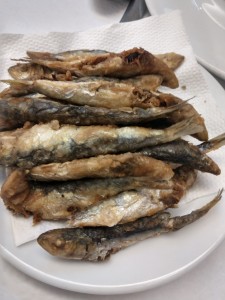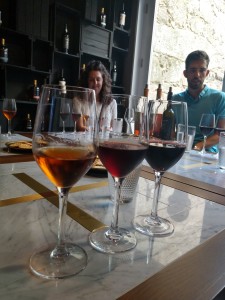To visit Portugal has been high on our list for a handful of years.
I read once that it was coastal, had great wines, still represented many areas of authentic, “the old ways” of life, was incredibly affordable and not yet overrun with tourists—or “touristic” as they prefer to say. We found all those things proved to be true.
Our first impressions occurred in the coastal city of Porto—known internationally for being the home-base of Port wine. Although we learned, witnessed and tasted that as evidence, we were told by our port-tasting guide that the Douro Valley (to the mountainous east of Porto) is actually where the overwhelming majority of the countries grapes are grown and wine, and port wine, is produced.
In fact, after most of the wine is made, it is then shipped to Porto to be stored-aged-sold, as the more consistent coastal temperature is more conducive to the aging process and stability of “the juice”–The names of the major producers displayed hugely above the buildings, south of the river in downtown Porto. Once upon a time the wine was shipped by boat upon that same Douro River—which runs from the coast of Portugal straight east into Spain—but now trucks carry the load. More on Douro in a later post. And, whether or not you should choose the highway versus the mountain “local” road if and when you visit wine country!
Porto, I suppose, is where the mountains of Douro sort of officially begin. As in most of the Portuguese western coast that we visited, the ascent from the sea begins immediately and significantly. Porto and Portugal are capital-H Hilly. If you’ve been to Tuscany, or Italy’s Amalfi coast, yeah, it’s like that. We climbed and climbed, feet and legs tested every day.
Porto, and Portugal, appear to me to be the “king” of tile-work. We walked “thousands” of miles in a week, and I’d be hard pressed to remember a sidewalk that wasn’t tiled. Houses too! Millions of artistically decorated tiles adorn much of the country—often colored blue due to the once-cheap and prolific supply of indigo). It’s quite remarkable and surely occurred over hundreds of years by way of thousands of hands—and knees.
Other things we learned of during our few days in Porto:
That sardines, as part of a huge fishing industry, are, like, everywhere. Canned, and displayed in food stores, in gift stores, (in the airport), on menus—and when not canned, displayed on ice, in menu photographs or on plates! I figured, outside of growing tourism related industries, a huge number of Portuguese people work in one of three industries: Fish/sardines, tile-work and winemaking. Everywhere you turn, all three are represented. I try to like sardines. I want to like sardines, I really do. It’s been a struggle. I find the wine, and cheese, so much more palatable.
And, from our guide on the last day in Porto:
“The spiciest food in Portugal registers a zero on the American scale”
“I used to rarely see an American on my tours and now they represent half”
“Drugs are legal on Portugal since 2001”
(As the country has successfully taken the stigma away from addiction and made treatment easier and associated crime greatly reduced)
“When eating seafood in Portugal, plan to get your hands dirty.”





I don’t think the title of your article matches the content lol. Just kidding, mainly because I had some doubts after reading the article.